3. Design Views
In this step, we will create views for the application.
3.1. Import the CSS file
To customize the appearance of HTML components we will use a CSS file.
- Select File > New > Other
- Expand Web and select CSS. Click Next
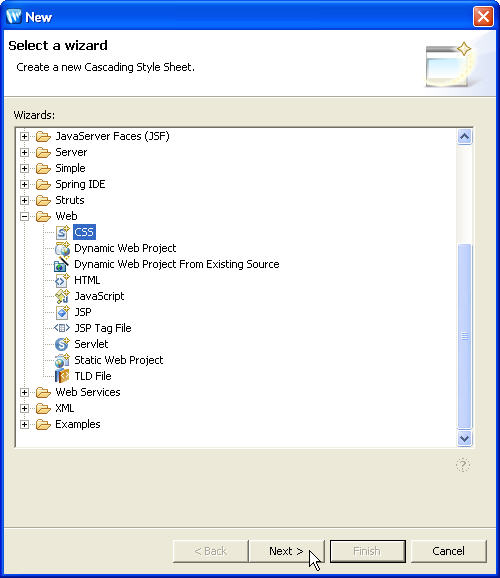
- Select the web folder and type stylesheet.css
for file name and click Finish .
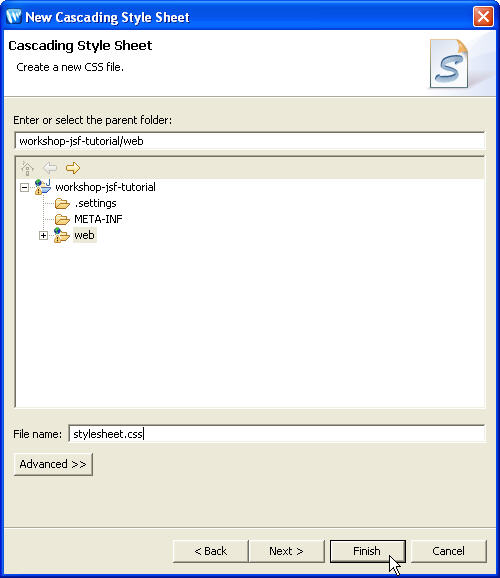
This creates a new file stylesheet.css under the web
application root folder i.e. web (Web App Root).
- Copy all the code from workshop-JSF-tutorial/web/Resources/stylesheet.css
file to web/stylesheet.css file.
- Save the stylesheet.css file.
3.2. Import images folder
In this application, we will place image files under the images folder.
- Select File > New > Folder
- In New Folder wizard select the parent folder workshop-JSF-tutorial/web and type folder name images
- Click Finish
- It creates new folder called images under the web application root folder i.e. web (Web App Root)
- Copy the image file banner.gif from the folder workshop-JSF-tutorial/web/Resources/images to the workshop-JSF-tutorial/web/images folder.
3.3. Create a view
In this step, we will create a JSP page named register.jsp that shows the user registration form.
- Select File > New > Other. Expand Web and click JSP. Click Next .
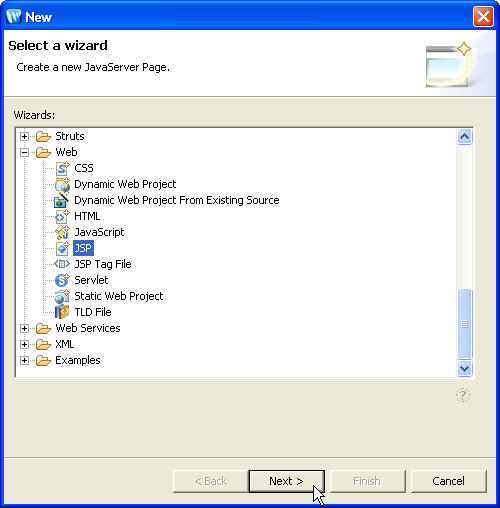
- Type register.jsp for file name and browse to folder workshop-JSF-tutorial/web/pages for the file location.
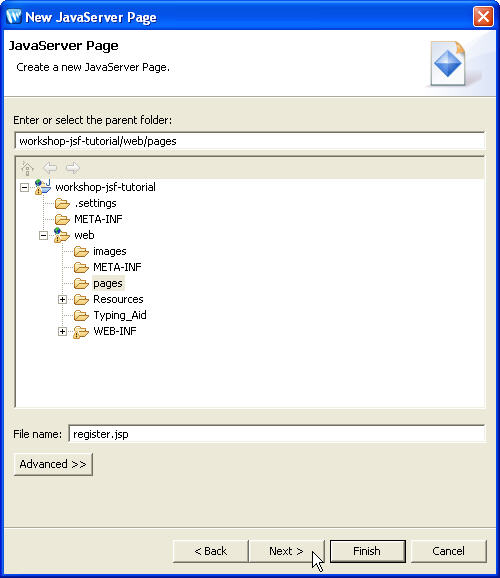
- Click Next
- From the next screen, simply click Next to accept the template.
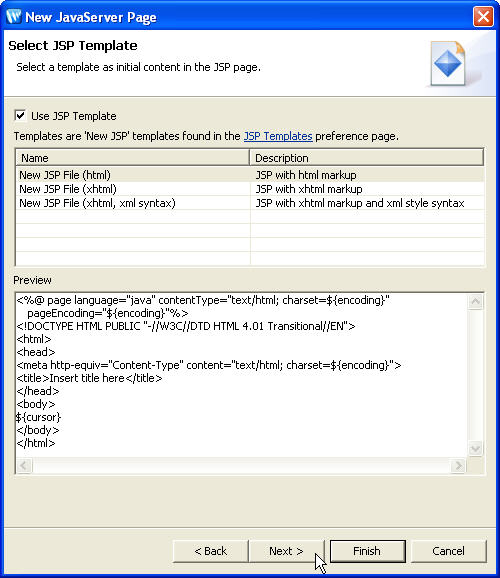
- From the next dialog, choose a resource bundle base name resources > application . This base name is used by the page register.jsp .

- Click Finish
- This creates an empty JSP file named register.jsp with the JSF tags <f:view> and <f:loadBundle> from JSF Core tag library. Open and review the code.
<!DOCTYPE HTML PUBLIC "-//W3C//DTD HTML 4.01 Transitional//EN">
<%@ page language="java" contentType="text/html; charset=iso-8859-1" %>
<%@ taglib uri="http://java.sun.com/jsf/html" prefix="h" %>
<%@ taglib uri="http://java.sun.com/jsf/core" prefix="f" %>
<f:loadBundle basename="resources.application" var="bundle"/>
<f:view>
<html>
<head>
<meta http-equiv="Content-Type" content="text/html; charset=iso-8859-1" />
<title>Untitled Document</title>
</head>
<body>
</body>
</html>
</f:view> |
By default, the taglib lines:
<%@ taglib uri="http://java.sun.com/jsf/html" prefix="h" %>
is not added to new JSP files.
Copy the line to your register.jsp file.
The basename attribute of the loadBundle
tag refers to the ResourceBundle located in
the resources package of the application. The basename
attribute must specify the fully qualified class name of the file.
3.4. Design the register.jsp view
In this step, we will add UI components to design the JSF page register.jsp.
To design the JSF page, you will use JSF tags which are readily available and displayed in Tag Libraries view.
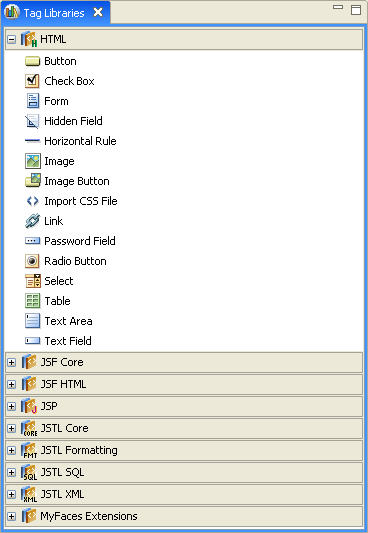
The Variables view displays lists of variables available
to the JSP page and facilitates insertion of those variables onto the page.
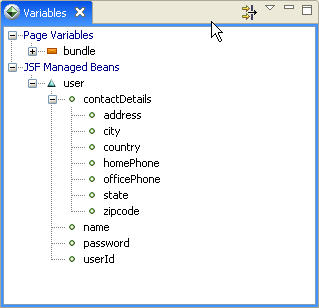
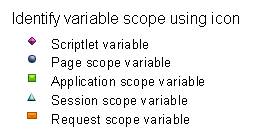
Information about the variable will be displayed on mouse-over for each variable.
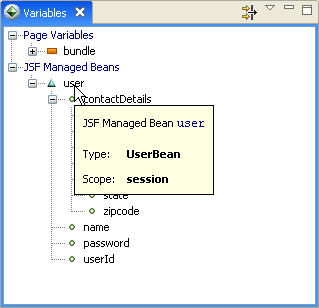
Right-click the Session scope variable user and observe the options in the
pop-up menu
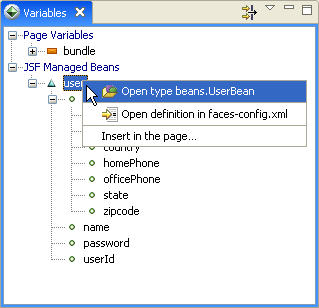
The pop-up menu shows the options to
- Navigate to the source file associated with the Java class of a variable
- Navigate to the variable definition in faces-config.xml file
- Insert the variable or its fields into a page
3.4.1. Specify the page title and stylesheet
- Remove the text Insert Title Here from
the <title> tag in register.jsp;
type <h: and press Ctrl+Space
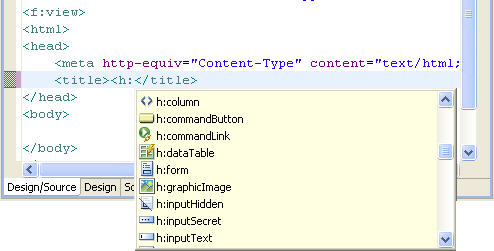
This displays list of tags from the JSF HTML tags libraries. This is one
of the most powerful features called Code Completion offered
by the Workshop AppXRay technology.
- From the list of tags select h:outputText
tag and press Enter. This adds the empty tag <h:outputText/>.
- Press the Space key before the closing outputText
tag. It displays the outputText attributes
list.
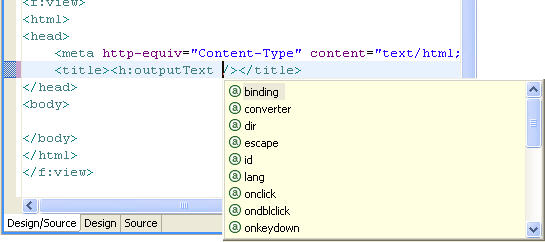
- Choose the attribute value for the <h:outputText>
tag.
- In the Smart Editor tab click the icon
 for the Value attribute.
for the Value attribute.
- In this Choose Binding dialog click the Resources
tab and click on the New Resource Key link.
- In the New Resource Key editor type in registerPageTitle
for the resource key and Register to Workshop…
for the resource value.
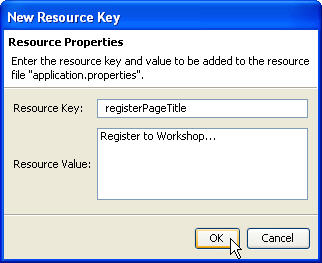
- Click OK on New Resource Key editor.
It adds new key/value pair in the resource bundle application.properties
file.
- Click OK on Choose Binding dialog.
- From the HTML tags list in the Tags Libraries
view, drag the
 Import CSS File tag to the Design
Editor (= the blank upper pane) of the register.jsp
page. It opens Choose File dialog. Choose the
file workshop-JSF-tutorial/web/stylesheet.css
Import CSS File tag to the Design
Editor (= the blank upper pane) of the register.jsp
page. It opens Choose File dialog. Choose the
file workshop-JSF-tutorial/web/stylesheet.css
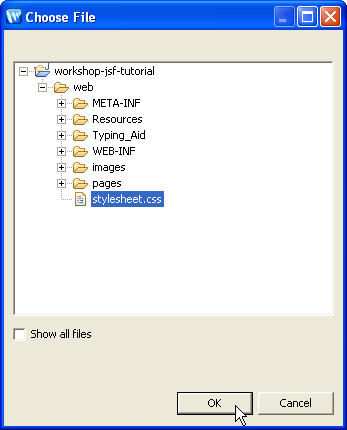
- This will add a <link> tag referencing
the CSS file before the </head> tag.
| <link rel="stylesheet" type="text/css" href="/stylesheet.css"> |
- Save register.jsp file.
3.4.2. Add HTML table
The WYSIWYG JSF Editor supports drag and drop of any tags from any Tab Library listed in the Tag Libraries view.
- From the HTML tags list in the Tags Libraries view, drag the
 Table tag to the Design Editor of register.jsp page. It opens a Table Tag dialog.
Table tag to the Design Editor of register.jsp page. It opens a Table Tag dialog.
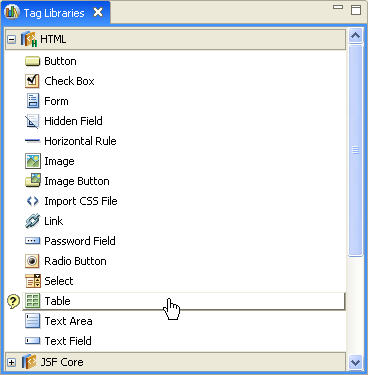
- In Table Tag dialog type the parameters as shown below:
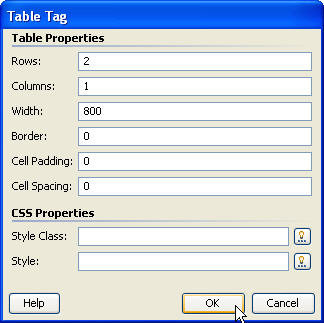
- Click OK
- This will add an HTML table tag in the body tag of register.jsp page.
3.4.3. Add an Image to the page
- Using the drag and drop feature of the editor, add the
 Graphic Image tag from the JSF HTML tag library to the first row of the HTML table.
Graphic Image tag from the JSF HTML tag library to the first row of the HTML table.
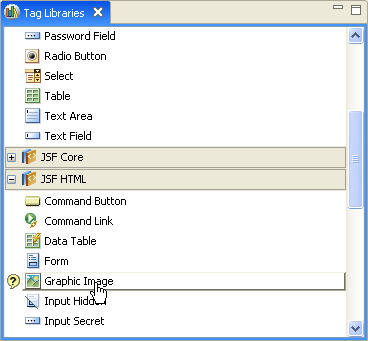
- Click the icon
 for URL and choose the image file banner.gif and click OK .
for URL and choose the image file banner.gif and click OK .
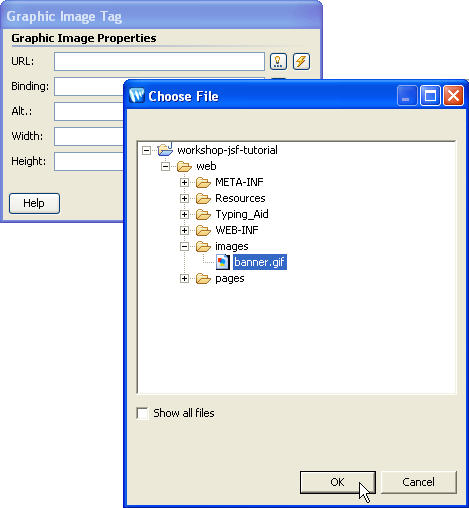
- Click the icon
 for
Alt (alternative text for image). In the Choosing
Binding dialog click the Resources tab and click
on the New Resource Key link.
for
Alt (alternative text for image). In the Choosing
Binding dialog click the Resources tab and click
on the New Resource Key link.
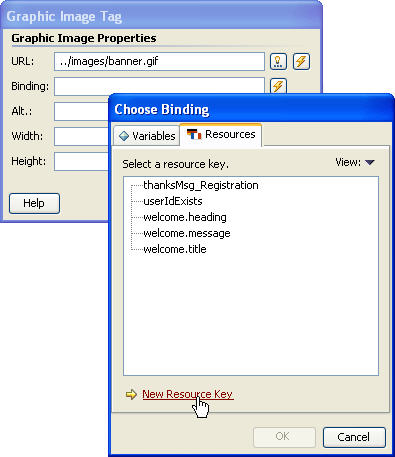
- In the New Resource Key editor type alt_img_text
for the resource key and BEA Workshop for JSF Editor
for the resource value.

- Click OK on the New Resource Key editor.
It adds a new key/value pair in the resource bundle application.properties
file.
- Click OK on the Choose Binding dialog.
- Click OK in the Graphic Image Tag
dialog.
- This will add a <h:graphicImage>
tag with attribute values in the first row of the HTML table. Save the register.jsp
page.
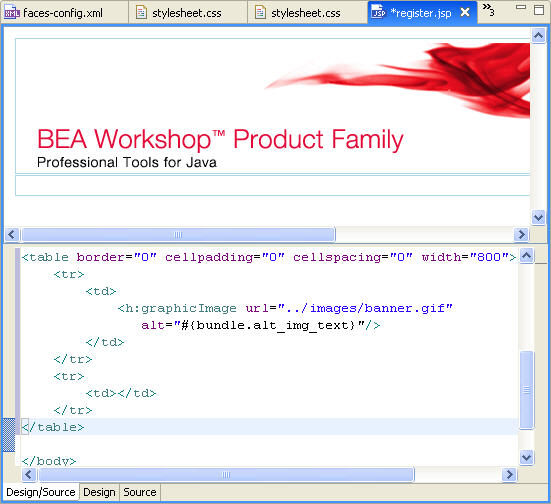
From the split-pane view, you can switch to a pure WYSIWYG (or
Design) Editor by clicking on the Design tab.
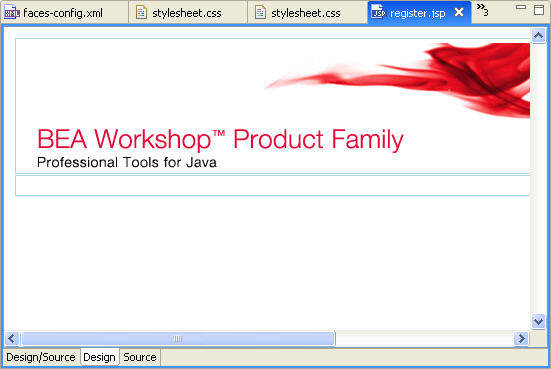
You also have flexibility of a professional Source Editor
to work with.
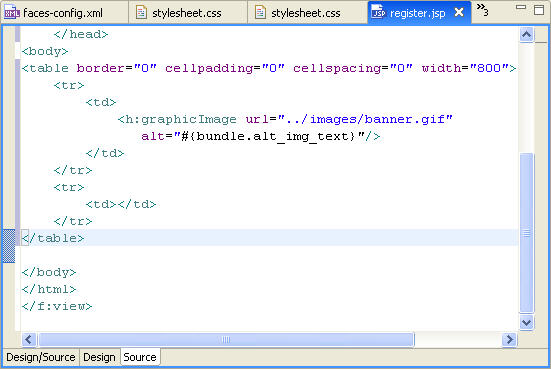
3.4.4. Add application message
During user registration the application should prompt the user to re-enter userId, if the userId entered already exists. The registerUser( ) method of UserBean appends FacesMessage to FacesContext if the userId already exists.
In the register.jsp page we will add a <h:messages>
tag to display error messages being added to FacesContext
during the request process.
- Using the drag and drop feature of the editor, add the
 Messages tag from the JSF HTML tag library to the second row of the HTML table.
Messages tag from the JSF HTML tag library to the second row of the HTML table.
- To set the attribute to true, select the
checkbox Global Only
- The messages will be displayed in table layout.
- To set the CSS stylesheet class, click the icon
 for Style Class . In the Choose CSS Style Class
dialog select validationMessage and click OK.
for Style Class . In the Choose CSS Style Class
dialog select validationMessage and click OK.
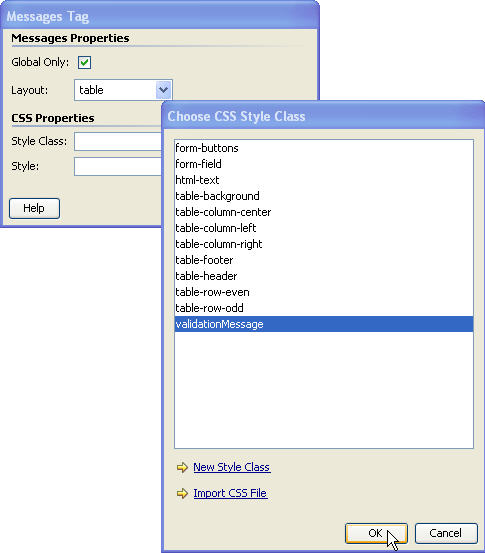
- Click OK in the Messages Tag dialog.
- This will add a <h:messages> tag
with attribute values in the second row of the HTML table.
- In the Design Editor press Enter after
the h:messages UI component.
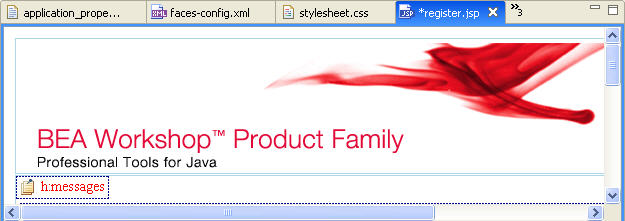
- Save the register.jsp page.
3.4.5. Add HTML Form, Form Fields and Validation Error Messages
Now we will add tags for an HTML form and form fields. We will also define
validators for various form fields. In the process we will learn different
features of Workshop for JSF.
- Using the drag and drop feature of the editor, add the
 Form tag from the JSF HTML tag library to the second row of the HTML table
after the h:messages placeholder.
Form tag from the JSF HTML tag library to the second row of the HTML table
after the h:messages placeholder.
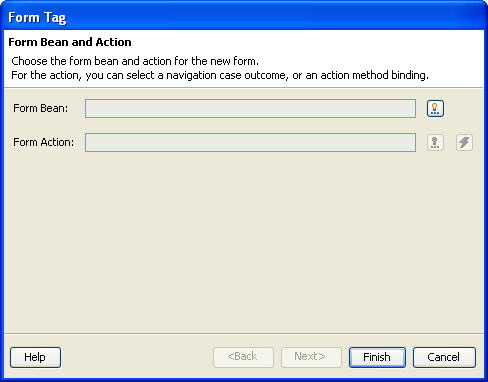
- Choose the form bean for the new form by clicking the icon
 for Form Bean. In the Choose Bean/Property dialog
select JSF Managed Bean user and click OK .
for Form Bean. In the Choose Bean/Property dialog
select JSF Managed Bean user and click OK .
- Choose the form action for the new form by clicking the icon
 for Form Action. In the Choose Method dialog
select registerUser method of user Managed
Bean and click OK
for Form Action. In the Choose Method dialog
select registerUser method of user Managed
Bean and click OK

- Click Next
- Select all the properties of user bean to be bound to
form input fields and click Next.
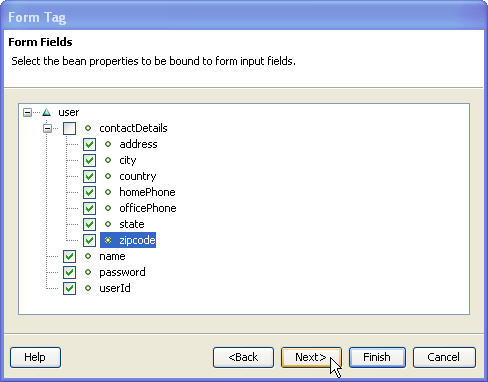
- In Form Tag dialog select the Input Type
for each form field and set the order as shown below:
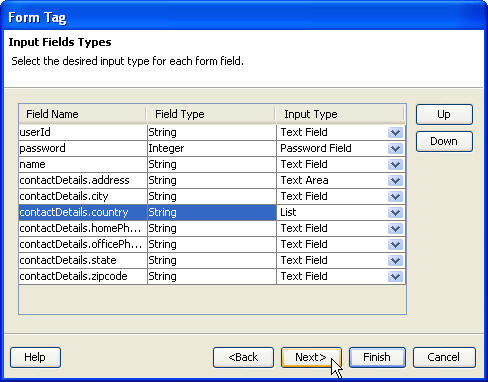
- Note that the Field Type of each field is set according
to the data-type of respective bean property.
- Click Next.
- Our application is required to display validation error messages. To accomplish
this, ensure that the Insert Validation Error Messages
check box is checked. Click the icon
 for Style Class and from the Choose CSS Style
Class dialog select the class validationMessage
and click OK.
for Style Class and from the Choose CSS Style
Class dialog select the class validationMessage
and click OK.

- Click Finish
This action will insert tags from the JSF HTML tag library. Specifically,
a <h:form> tag containing a <h:panelGrid>
tag for the HTML table; <h:outputText>
tags for form field labels; <h:inputText>,
<h:selectOneListbox> and <h:inputTextarea>
tags for form fields and <h:message>
tags for validation error messages.
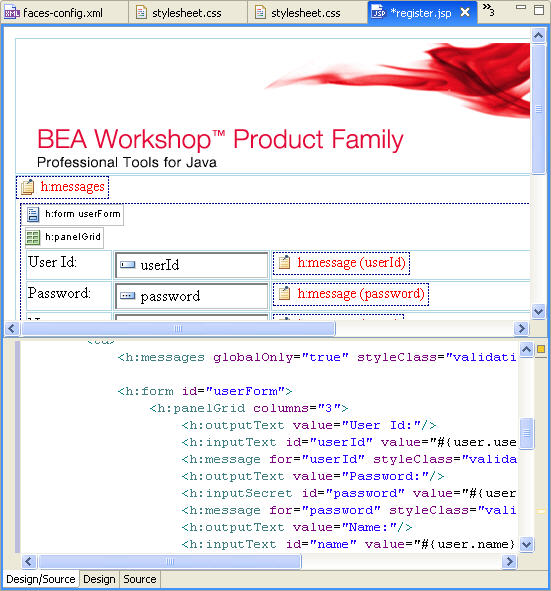
Also note the tag <h:commandButton>
with action attribute (which refers to the UserBean.registerUser(
) method) being added.
The for attribute value of <h:message>
tag refers to the id attribute value of
the respective form field.
3.4.6. Using the Property sheet and Smart Editor
The registration form has JSF HTML UI component selectOneListbox
that shows a list of countries. We will use the Properties Sheet
and Smart Editor tabs to add items to the list and specify
its properties. In this process we will understand the difference between
the Property Sheet and Smart Editor facilities.
In the Design Editor select the country list box. The Properties
view displays a list of attributes defined for the <h:selectOneListbox>
tag and the source window shifts to the corresponding tag.
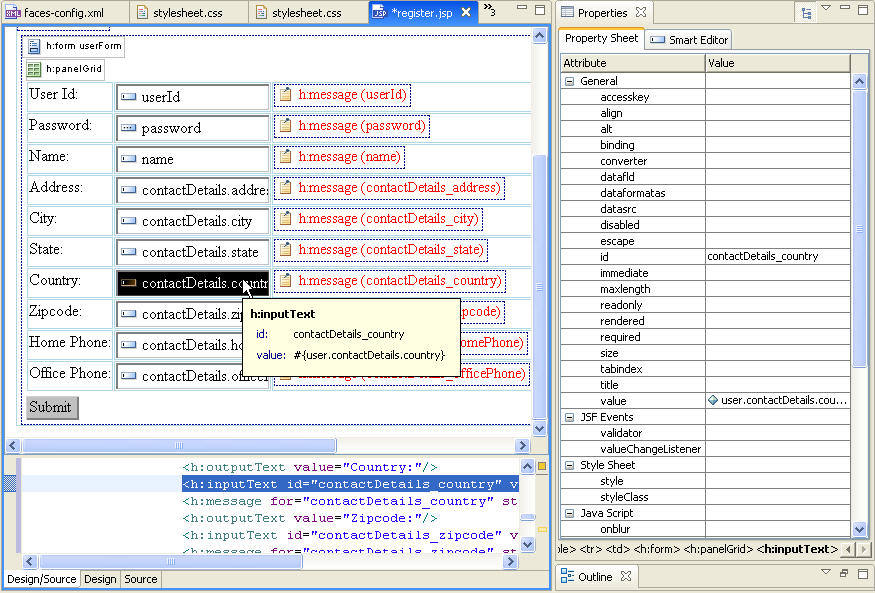
The Properties Sheet UI lists all the tag attributes and
their values. Depending on the attribute type, an attribute value picker is
displayed to help with editing the attribute value.
The Smart Editor view provides UI for efficient editing.
In the Smart Editor click the icon  for the Static Items attribute and add the itemLabels and
itemValues in the Edit Select Item List dialog as shown
below:
for the Static Items attribute and add the itemLabels and
itemValues in the Edit Select Item List dialog as shown
below:

3.4.7. Synchronized Editing
The WYSIWYG JSF (Design) editor view, Source Editor
view, Properties view and Outline view are
synchronized with each other. This means any real-time changes being made
in one view are immediately reflected in other views.
In the Smart Editor view, for the country list tag choose
the option Menu for Rendering Properties Type.
This will change the Country list tag from <h:selectOneListbox>
tag to <h:selectOneMenu> tag.
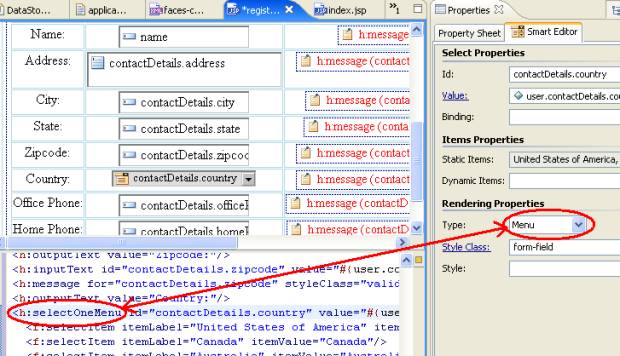
3.4.8. Insert table header and footer
- In the Design Editor, right-click the
h:panelGrid component to open the pop-up
menu and select Panel Grid > Insert Table Header.
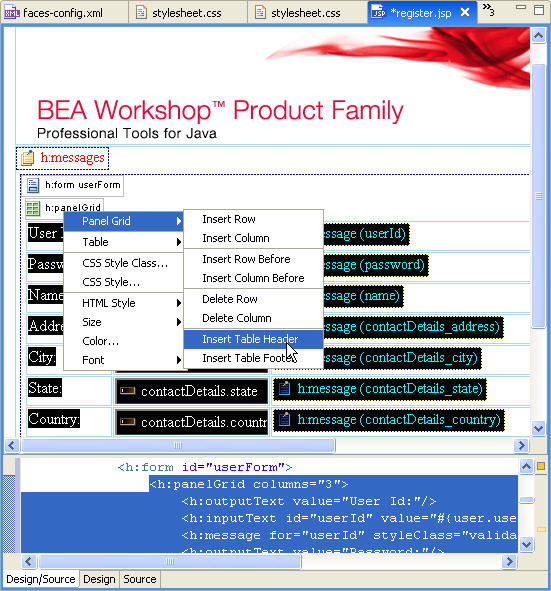
This will add a table header row using the <f:facet>
tag from the JSF Core tags library.
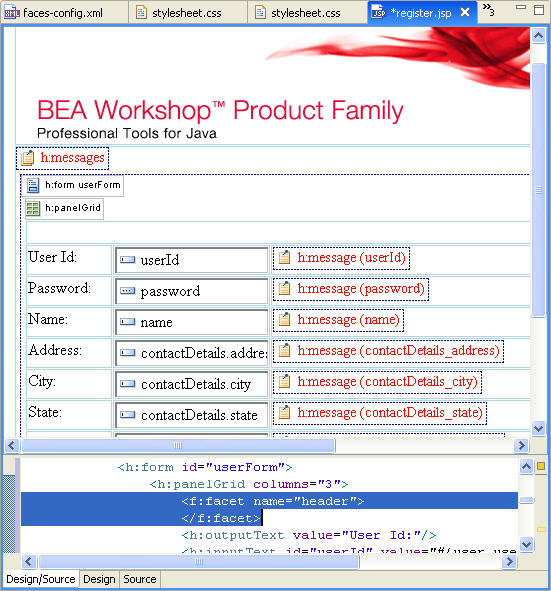
- Drag the
 Output
Text tag from the JSF HTML tag library and drop it in the table header
row.
Output
Text tag from the JSF HTML tag library and drop it in the table header
row.
- In the Output Text Tag dialog click the icon
 for Value. In the Choosing Binding dialog
click the Resources tab and click on the New Resource
Key link.
for Value. In the Choosing Binding dialog
click the Resources tab and click on the New Resource
Key link.
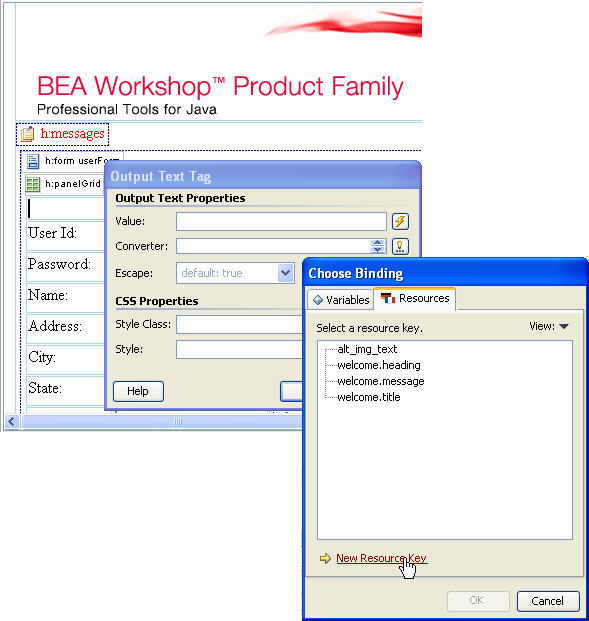
- In the New Resource Key editor type in registerFormHeader
for the resource key and Member Registration
for the resource value.

- Click OK on the New Resource Key dialog.
This adds a new key/value pair in the resource bundle application.properties
file.
- Click OK on the Choose Binding dialog.
- Click OK on the Output Text Tag dialog.
- Similarly add a table footer to the h:panelGrid
component.
- Cut and paste the Submit button into the table footer.
- Save register.jsp page.
3.4.9. Specify style class for table
- In the Design Editor select the h:panelGrid
component.
- In the Smart Editor click the icon
 for Table Class and in the Choose CSS Style Class
dialog select the option table-background and
click OK
for Table Class and in the Choose CSS Style Class
dialog select the option table-background and
click OK
- For the Column Classes table properties click the icon
 and in the Edit
Style Values dialog select the styles for three columns as shown
below and click OK
and in the Edit
Style Values dialog select the styles for three columns as shown
below and click OK

- We have specified a CSS style class for the table and table columns. Now
set the CSS style class for the table header and footers.
- In the Properties view select the Property Sheet
tab view and click the headerClass Style Sheet
attribute. From the Choose CSS Style Class dialog select
the style-class table-header and click OK
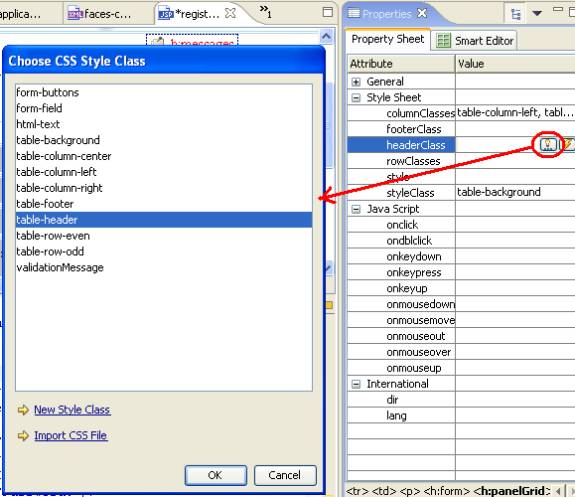
- Similarly select the style-class table-footer for the footerClass Style Sheet attribute.
- For each field in the form specify the CSS style-class form-field.
- Save the register.jsp page.
3.4.10. Define validators for form-fields
Next we will identify validation rules for the HTML form fields. The table
shown below describes validation rules / criteria for some of the form fields.
 |
 |
 |
 |
| Form Field |
Field Type (Input Type) |
Validation rule / criteria |
| User Id |
String (Text field) |
Value is required and should be minimum 4 characters and maximum
8 characters. |
| Password |
String (Password field) |
Value is required and should be between 1000 and 9999 (inclusive). |
| Name |
String (Text field) |
Value is required. |
| Address |
String (Text Area) |
Value is required. |
| City |
String (Text field) |
Value is required. |
| Country |
String (List) |
Value is required. |
| Zip code |
String (Text field) |
Value is required. |
|
 |
 |
 |
 |
- In the Design Editor select the userId
text field. The Smart Editor view displays the attributes
of <h:inputText> tag for the userId
text field. Check the Required checkbox under the Validation
section. This will add an attribute required="true"
to the userId text field tag.
- Click the icon
 for
Validators. In the Edit Validators dialog
click the Add button and select the option Length
Validator
for
Validators. In the Edit Validators dialog
click the Add button and select the option Length
Validator

- In the Length Validator Tag dialog type 4
for Min. Length field and 8 for Max.
Length field and click OK.
- This will add a JSF standard Length Validator to the
validators list for the userId text field. Click OK.
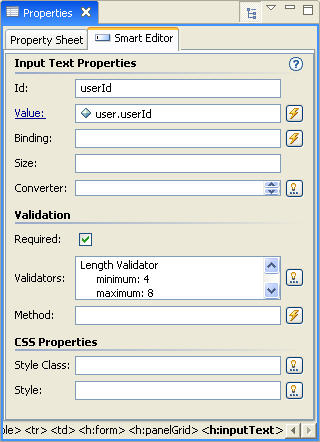
The <f:validateLength> tag from the
JSF Core tag library will be added to the userId
input text field.
- In the Design Editor select the password
text field. The Smart Editor view displays attributes of
the <h:inputText> tag for the password
text field. Check the Required checkbox under the Validation
section. This will add an attribute required="true"
to the password text field tag.
- Click the icon
 for
Validators. In the Edit Validators dialog
click the Add button and select the option Long
Validator.
for
Validators. In the Edit Validators dialog
click the Add button and select the option Long
Validator.
- In the Long Validator Tag dialog type 1000
for Min. Value field and 9999 for
Max. Value field and click OK.
- This will add a JSF standard Long Validator to the validators
list for the password text field. Click
OK.
The <f:validateLongRange>
tag from the JSF Core tag library will be added to password
input text field.
- For each form field (i.e. name, city, zipcode, and country) check the
Required validation attribute.
- Select the Address form field and in Smart Editor
type the value 25 for Columns
and the value 3 for Rows. In Property
Sheet specify true for the required
attribute.
We need to specify the symbol ( * ) for
each form field that requires input value.
- In Design Editor type the symbol *
after the userId input text field. This
will insert the symbol * in the <f:verbatim>
tag from the JSF Core tag library.
- Select the symbol * to specify the CSS
style-class. Right-click to open pop-up menu and select CSS Style
Class > html-text
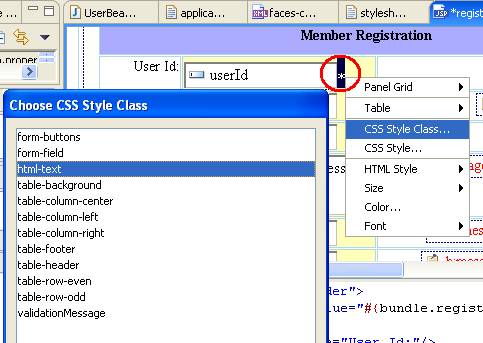
- This will apply the style-class html-text
to the symbol * using the <span>
tag.
- For each form field (i.e. password, name, address, city, zipcode, and
country) add the symbol * and apply the
style-class html-text
- Save the register.jsp page.
3.4.11. Localize UI Component labels
In an internationalized application the GUI component labels should be localized.
Hence, we will bind the UI component labels to the dynamic values from the
application resource bundle.
- In application.properties file add key-value pairs for form field labels and save the file. You can copy from workshop-JSF-tutorial/web/Typing_Aid/application_properties_1.txt
userId=User ID\:
password=Password\:
name=Name\:
address=Address\:
city=City\:
state=State\:
country=Country\:
zipcode=Zipcode\:
officePhone=Phone (Off.)\:
homePhone=Phone (Home)\:
submit=Submit
reset=Reset |
- In the Design Editor select the label User
Id: for the userId text field. The Smart Editor
view displays attributes of the <h:outputText>
tag for the User Id: text label.
- In the Smart Editor click the icon
 for Value output text property. In the Choose Binding
dialog choose the resource key userId under the Resources
view and click OK
for Value output text property. In the Choose Binding
dialog choose the resource key userId under the Resources
view and click OK
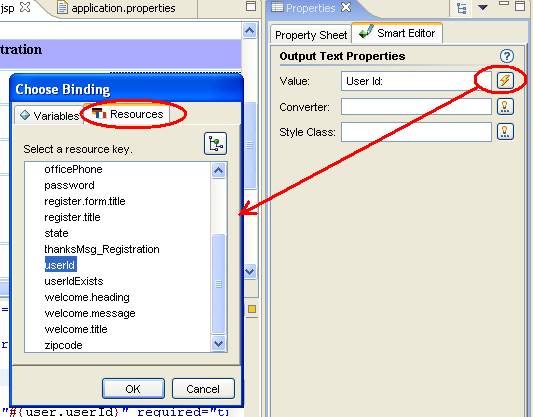
- This will dynamically bind the value attribute of <h:outputText> tag to the userId key value from the application resource bundle.
- Similarly bind the labels of other UI components (i.e. password, name, address, city, state, zipcode, country, office phone and home phone, submit) to the respective key value from the application resource bundle.
- Save the register.jsp page.
3.4.12. Observe variables available to JSP page
Workshop automatically detects the variables available to be used in a JSP
page and provides a list to select from. This reduces development time and
minimizes errors.
- In Design Editor select the userId
text field. The Source Editor view displays the selected
<h:inputText> tag for the userId
text field.
- Remove user.userId text from the value
attribute of <h:inputText> tag for
the userId text field and press Ctrl+Space
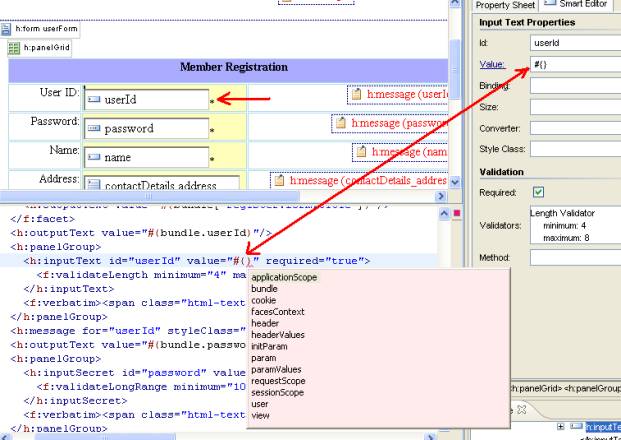
Workshop shows list of variables available to be used in JSF page.
- Reset the value attribute of <h:inputText>
tag for the userId text field to #{user.userId}
3.4.13. Code completion and error checking for the JSF Managed beans
Workshop has a deep understanding of the application and builds a database
to store that understanding. It provides code completion for the variables
and methods of JSF Managed Beans.
- In Design Editor select the Submit
button. The Source Editor view displays the selected <h:commandButton>
tag for the Submit button.
- Remove registerUser text from the value
attribute of the <h:commandButton>
tag for the Submit button and press Ctrl+Space
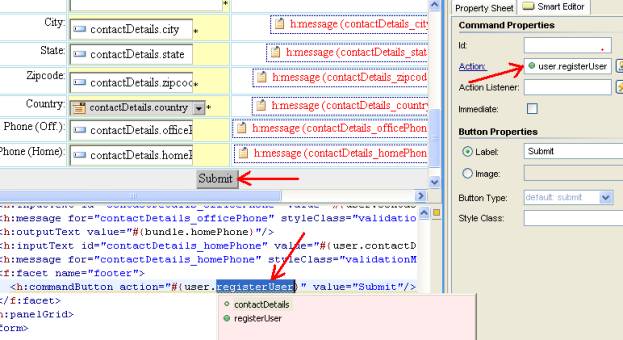
Workshop provides code completion by showing methods of Managed Bean UserBean.
- Reset the value attribute of <h:commandButton>
tag to #{user.registerUser}
3.4.14. Real-time Error Checking
With its deep knowledge of the application, Workshop immediately see potential errors and provides real-time error checking.
Workshop will create a warnings/errors manifest of all the affected files.
The manifest will go beyond affected Java files and will include files at
all levels including the JSP pages and XML configuration files.
- If you edit the value attribute of the
<h:inputText> tag for the userId
text field with the value #{user.Id} then
the Source Editor shows the warning icon.
- If you save the register.jsp page then the Problems
view shows warning message saying that the Id
field is undefined for the Managed Bean beans.UserBean.
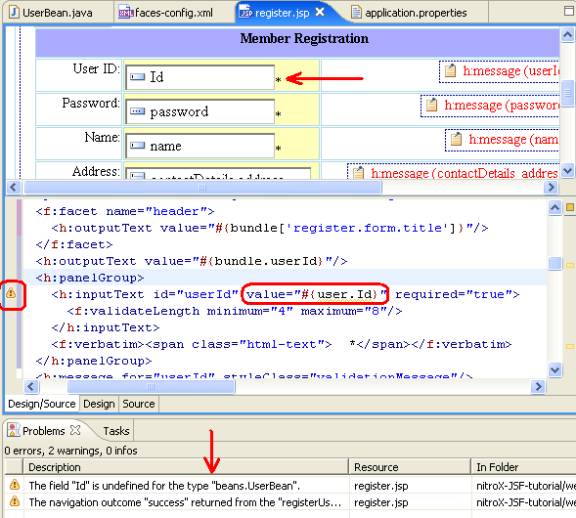
- Reset the value attribute to #{user.userId}.
- In the UserBean class edit the getPassword(
) method name to getPass( ) and save
UserBean class.
- The Problems view shows warning message for the register.jsp
resource saying that the field password
is undefined for the Managed Bean beans.UserBean.
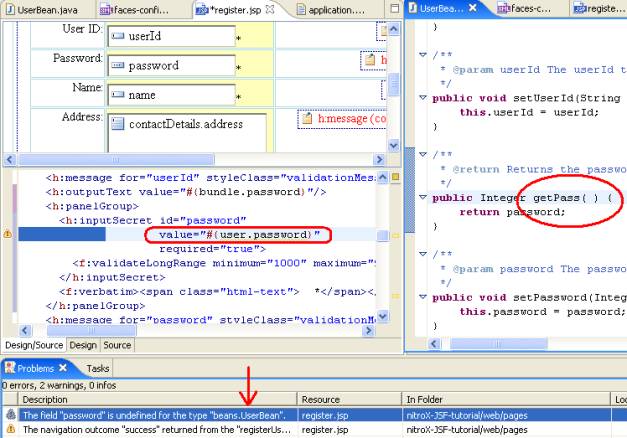
- In the UserBean class reset the method
name getPass( ) to getPassword(
) and save UserBean class.
Click one of the following arrows to navigate through the tutorial:













 for the Value attribute.
for the Value attribute. 



















![]() for the Static Items attribute and add the itemLabels and
itemValues in the Edit Select Item List dialog as shown
below:
for the Static Items attribute and add the itemLabels and
itemValues in the Edit Select Item List dialog as shown
below: 














